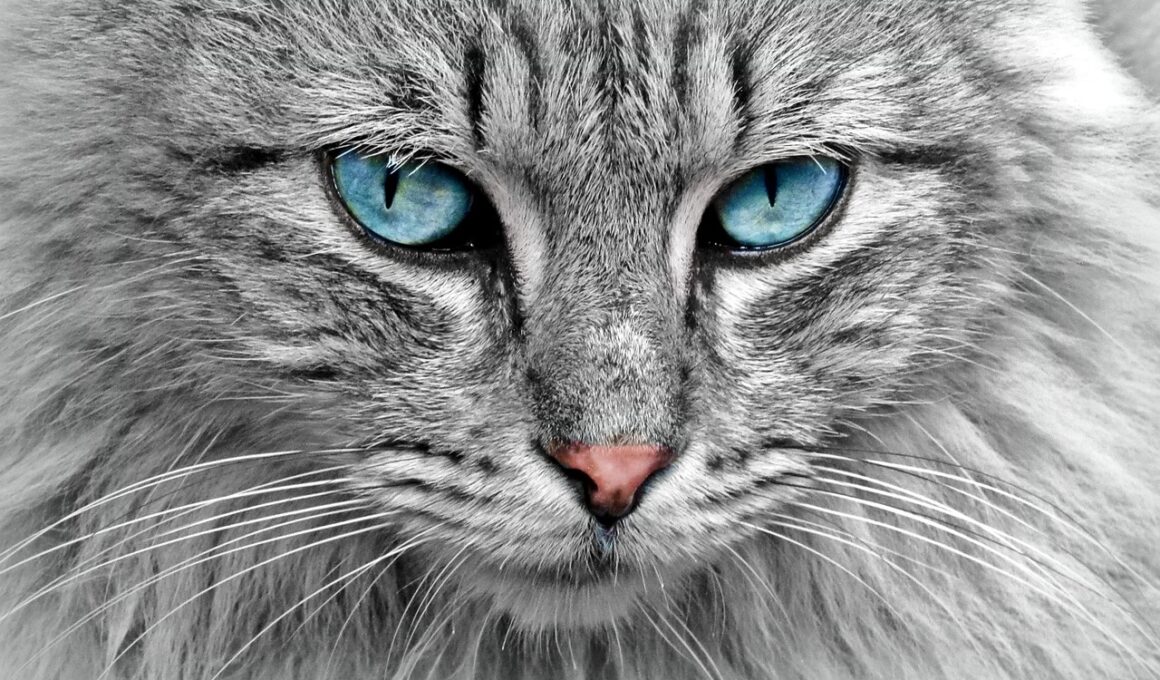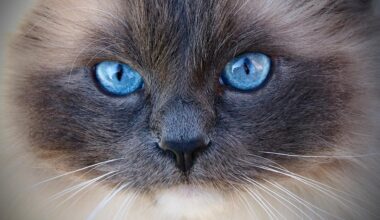The Role of Diet in Maintaining Your Cat’s Skin and Coat
The health of your cat’s skin and coat is significantly impacted by their diet. A well-balanced diet ensures that your feline friend receives essential nutrients that promote healthy skin and a shiny coat. Cats require a variety of nutrients, including proteins, fats, vitamins, and minerals, to thrive. Proteins serve as the building blocks of skin and coat health, fostering cell growth and repair. Additionally, the right balance of fatty acids, particularly omega-3 and omega-6, helps maintain the skin’s natural barrier function. This, in turn, prevents moisture loss and reduces irritation and infection risks. Incorporating high-quality protein sources into your cat’s meals is fundamental, as they are obligate carnivores. This dietary requirement emphasizes the importance of including meat-based proteins in their diet. Also, ensure to provide access to clean, fresh water to support hydration and overall well-being. It’s important to consult with your veterinarian about the best dietary practices tailored to your cat’s specific age, health status, and activity level. A tailored diet promotes not only a beautiful coat but overall health and quality of life.
Key Nutrients for Skin and Coat Health
Several critical nutrients contribute to the overall health of your cat’s skin and coat. First, protein plays a vital role in the structure of the skin and hair follicles. Without sufficient quality protein, your cat may experience hair thinning or skin issues. Healthy fats, like omega fatty acids, also support skin hydration and elasticity. Omega-3 fatty acids found in fish oil are particularly beneficial for reducing inflammation and promoting healing. Furthermore, vitamins A, E, and certain B vitamins hold significance in skin health. Vitamin A helps regulate skin cell production, while Vitamin E acts as an antioxidant, reducing oxidative stress. B vitamins, especially biotin, support a healthy coat by promoting its shininess and texture. Minerals like zinc and copper are also essential for skin health, aiding in cell renewal and preventing infections. Incorporating a variety of protein sources, healthy fats, and vitamins will create a comprehensive diet that can enhance your cat’s skin and coat conditions. Consider using high-quality commercial cat foods that list meat as the primary ingredient to ensure they are meeting these nutrient needs.
In addition to selecting high-quality cat food, frequent treats should also be considered when assessing your cat’s diet. Treats that are rich in omega-3s can reinforce the nutrient intake necessary for skin and coat health. However, it is crucial to monitor the amount of treats given, as overindulgence can lead to obesity and related health problems. Homemade options can also be beneficial, including cooked fish or chicken as occasional rewards. Again, avoid any potentially harmful foods such as garlic or onions, which are toxic to cats. Always prioritize moderation and balance in both meals and treats. A regular check-up with your veterinarian will help ensure your cat is maintaining a healthy diet. They can provide dietary recommendations and necessary adjustments suited to your cat’s health. Additionally, be alert to any changes in your cat’s coat condition, such as excessive shedding or dryness. These could be warning signs of deeper health concerns related to nutrition or underlying medical issues. Your cat’s diet can drastically affect its fur and skin. Therefore, ensuring a nutritious and balanced diet is paramount for maintaining health and beauty.
Hydration and Its Impact on Skin Health
Hydration is often overlooked, yet it plays a crucial role in your cat’s skin and coat health. Cats are notoriously susceptible to urinary tract issues if they are not adequately hydrated, which can lead to further complications affecting their overall skin condition. Drinking sufficient water helps in nutrient absorption and digestion, both of which are essential for skin health. To promote hydration, encourage your cat to drink more water by providing fresh and clean water at all times. Consider investing in a pet water fountain, as many cats prefer running water. Additionally, wet or canned cat food can contribute to your cat’s daily water intake. This is especially beneficial if your cat does not drink a lot of water by itself. Ensuring hydration is essential for overall health and well-being. Understanding your cat’s habits and preferences can make a big difference. Monitor the water intake and ensure they are consuming enough to help maintain proper hydration levels. A hydrated cat is a happy cat! So, taking these small steps can greatly improve your pet’s skin and coat condition over time.
Regular grooming also complements a proper diet in promoting an optimal environment for your cat’s skin and coat health. Grooming helps remove loose hair, dirt, and debris, which can hinder skin health. It also stimulates blood circulation, promoting the healthy growth of hair follicles. Regular brushing aids in distributing natural oils produced by your cat’s skin, which helps moisturize their fur and prevent dryness. Depending on your cat’s breed, the frequency of grooming may vary. Long-haired breeds may require daily grooming sessions, while short-haired varieties might only need weekly attention. Establishing a grooming routine early in your cat’s life will help them adjust to the process. Providing positive reinforcement, like treats or affection, during grooming will make it a pleasant experience for both of you. A well-groomed cat not only looks better, but its overall skin condition will also be better maintained, reflecting the benefits of both diet and grooming. Never underestimate the role of grooming in partnership with a nutritious diet. Both aspects support skin health and enhance your cat’s physical appearance and overall happiness.
Monitoring for Allergies and Sensitivities
As you focus on diet and grooming for your cat, it’s essential to monitor for any allergens or sensitivities that may affect their skin health. Cats can suffer from food allergies, leading to skin irritations, itching, and even infections. Typically, common allergens include certain proteins, grains, and additives. Observing any sudden changes in your cat’s coat or behavior can provide early signals of allergies. If you notice excessive scratching, grooming, or hair loss, it may be time to consult your veterinarian. To diagnose food allergies, elimination diets can be employed, removing suspected allergens for a period. After that, reintroducing them one at a time enables you to identify the specific trigger. Once established, you can adjust your cat’s diet to exclude those allergens. This may take time, but is critical for maintaining a healthy skin and coat. Furthermore, environmental allergens such as pollen, dust, and mold can also cause skin issues. Their impact increases during certain seasons when allergens are more prevalent. Maintaining a clean living environment can mitigate these issues.
Integrating a holistic approach to your cat’s care, including diet, grooming, and health monitoring, will significantly bolster their skin and coat health. These three aspects work in synergy to help your feline friend thrive and exhibit vibrant fur as well as healthy skin. Providing a balanced and nutritious diet ensures that all necessary nutrients are supplied to fortify skin and coat health. Complementing a proper diet with regular grooming encourages the maintenance of separated skin and coat while fostering your bond. Monitor possible allergies and sensitivities to quickly address any issues that could disrupt the benefits gained from diet and grooming practices. By understanding your cat’s unique needs and behaviors, you can design a care routine that promotes a beautiful coat and vibrant skin health. Additionally, keeping an open line of communication with your veterinarian will support this goal by allowing you to stay proactive about any potential health concerns. Embrace a comprehensive approach to care that will benefit your beloved pet! With time, you are sure to notice the positive effects on your cat’s skin and coat, enhancing their overall quality of life.


